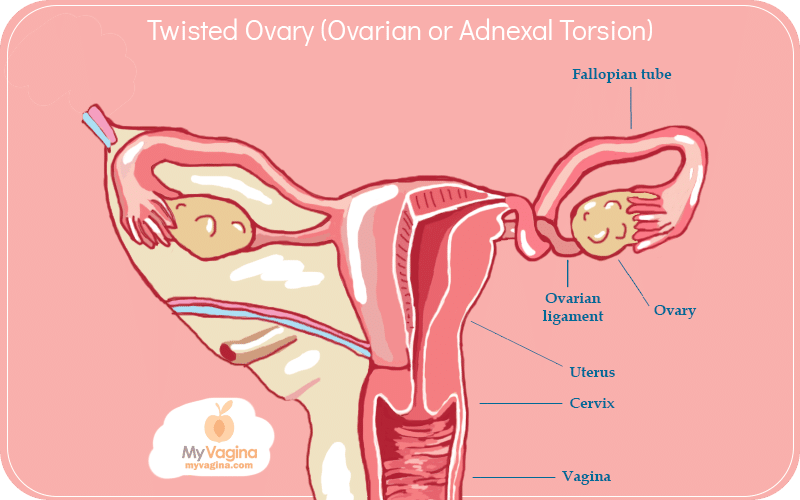Adnexal torsion is the extremely painful process of twisting of the ovary on its ligament, and sometimes the fallopian tube, thereby cutting off blood-flow to the organs. This is an emergency situation, and requires urgent medical care to preserve the ovary.
Symptoms of ovarian or adnexal torsion
- Sudden, severe pain in the abdomen/pelvis
- Vomiting, nausea
- Beforehand, perhaps cramping for days or sometimes even weeks
- Colicky pain intermittently
- Ovary pain may occur, then go away, as the ovary repeatedly twists and untwists
- Tender abdomen
Why does twisting of the ovary or fallopian tube happen?1–3
The ovaries are attached via ligaments to the uterus and other structures around them – they aren’t just free-floating like the diagrams would have us believe.
Sometimes the ovary can twist, and sometimes it might involve the fallopian tube. The most common cause is a problem with an ovary, for example during pregnancy, while using fertility hormones that trigger ovulation, and when the ovary is enlarged for some reason, perhaps due to a benign or cancerous cyst or tumour.
Normal ovaries very rarely twist, which more often occurs in children. Adnexal torsion normally only happens on one side, and only to the ovary.
When the blood supply is cut off for long enough, the ovary tissue can die which is irreversible. If this goes untreated, it can cause infection in the abdominal cavity and nearby tissues.
Treatment for ovarian or fallopian tube torsion
Surgery is used to untwist the ovary, which may mean opening up the abdomen with one large incision and visually moving the ovary back into place, or using smaller incisions and a viewing scope.
This less invasive procedure involves a small incision in the abdomen, with a viewing scope (laparoscope) inserted into one incision, and instruments in others to untwist the ovary (and if required, the fallopian tube). The less invasive procedure is done in a hospital, typically under general anaesthetic. No overnight stay is required unless the larger incision is made. 4
If an ovarian cyst is present, this might be removed at the time or scheduled for a later visit (a cystectomy).5 If the tissue died, the fallopian tube and ovary will be removed. This operation is called a salpingo-oophorectomy. If there is a tumour, the ovary may be removed (oophorectomy).
References
- 1.Bridwell RE, Koyfman A, Long B. High risk and low prevalence diseases: Ovarian torsion. The American Journal of Emergency Medicine. Published online June 2022:145-150. doi:10.1016/j.ajem.2022.03.046
- 2.Dawood MT, Naik M, Bharwani N, Sudderuddin SA, Rockall AG, Stewart VR. Adnexal Torsion: Review of Radiologic Appearances. RadioGraphics. Published online March 2021:609-624. doi:10.1148/rg.2021200118
- 3.Ding DC, Huang C, Hong MK. A review of ovary torsion. Tzu Chi Med J. Published online 2017:143. doi:10.4103/tcmj.tcmj_55_17
- 4.Balasubramaniam D, Duraisamy K, Ezhilmani M. Laparoscopic detorsion and fertility preservation in twisted ischemic adnexa – A single-center prospective study. Gynecol Minim Invasive Ther. Published online 2020:24. doi:10.4103/gmit.gmit_20_19
- 5.Tsafrir Z, Hasson J, Levin I, Solomon E, Lessing JB, Azem F. Adnexal torsion: cystectomy and ovarian fixation are equally important in preventing recurrence. European Journal of Obstetrics & Gynecology and Reproductive Biology. Published online June 2012:203-205. doi:10.1016/j.ejogrb.2012.02.027

Get a fresh perspective with a qualified, experienced vulvovaginal specialist naturopath.
This product has multiple variants. The options may be chosen on the product page
The most comprehensive vaginal microbiome test you can take at home, brought to you by world-leading vaginal microbiome scientists at Juno Bio.

Promote and support a protective vaginal microbiome with tailored probiotic species.







